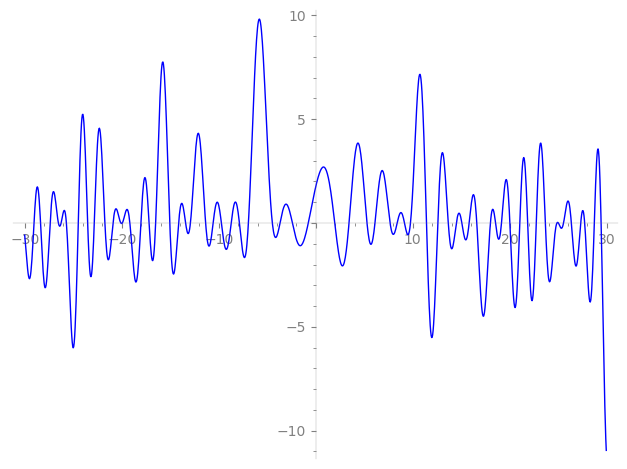| L(s) = 1 | + (−1.13 − 2.59i)2-s + 6.25·3-s + (−5.44 + 5.86i)4-s + (−7.07 − 16.2i)6-s − 34.6i·7-s + (21.3 + 7.47i)8-s + 12.1·9-s + 7.91i·11-s + (−34.0 + 36.6i)12-s + 11.0·13-s + (−89.7 + 39.1i)14-s + (−4.78 − 63.8i)16-s + 57.6i·17-s + (−13.7 − 31.5i)18-s − 141. i·19-s + ⋯ |
| L(s) = 1 | + (−0.399 − 0.916i)2-s + 1.20·3-s + (−0.680 + 0.733i)4-s + (−0.481 − 1.10i)6-s − 1.86i·7-s + (0.943 + 0.330i)8-s + 0.450·9-s + 0.216i·11-s + (−0.819 + 0.882i)12-s + 0.235·13-s + (−1.71 + 0.747i)14-s + (−0.0748 − 0.997i)16-s + 0.821i·17-s + (−0.180 − 0.412i)18-s − 1.70i·19-s + ⋯ |
\[\begin{aligned}\Lambda(s)=\mathstrut & 200 ^{s/2} \, \Gamma_{\C}(s) \, L(s)\cr =\mathstrut & (-0.717 + 0.696i)\, \overline{\Lambda}(4-s) \end{aligned}\]
\[\begin{aligned}\Lambda(s)=\mathstrut & 200 ^{s/2} \, \Gamma_{\C}(s+3/2) \, L(s)\cr =\mathstrut & (-0.717 + 0.696i)\, \overline{\Lambda}(1-s) \end{aligned}\]
Particular Values
| \(L(2)\) |
\(\approx\) |
\(0.656364 - 1.61835i\) |
| \(L(\frac12)\) |
\(\approx\) |
\(0.656364 - 1.61835i\) |
| \(L(\frac{5}{2})\) |
|
not available |
| \(L(1)\) |
|
not available |
\(L(s) = \displaystyle \prod_{p} F_p(p^{-s})^{-1} \)
| $p$ | $F_p(T)$ |
|---|
| bad | 2 | \( 1 + (1.13 + 2.59i)T \) |
| 5 | \( 1 \) |
| good | 3 | \( 1 - 6.25T + 27T^{2} \) |
| 7 | \( 1 + 34.6iT - 343T^{2} \) |
| 11 | \( 1 - 7.91iT - 1.33e3T^{2} \) |
| 13 | \( 1 - 11.0T + 2.19e3T^{2} \) |
| 17 | \( 1 - 57.6iT - 4.91e3T^{2} \) |
| 19 | \( 1 + 141. iT - 6.85e3T^{2} \) |
| 23 | \( 1 + 129. iT - 1.21e4T^{2} \) |
| 29 | \( 1 + 89.1iT - 2.43e4T^{2} \) |
| 31 | \( 1 + 78.3T + 2.97e4T^{2} \) |
| 37 | \( 1 - 249.T + 5.06e4T^{2} \) |
| 41 | \( 1 - 91.8T + 6.89e4T^{2} \) |
| 43 | \( 1 + 194.T + 7.95e4T^{2} \) |
| 47 | \( 1 + 72.6iT - 1.03e5T^{2} \) |
| 53 | \( 1 - 456.T + 1.48e5T^{2} \) |
| 59 | \( 1 - 341. iT - 2.05e5T^{2} \) |
| 61 | \( 1 - 217. iT - 2.26e5T^{2} \) |
| 67 | \( 1 - 529.T + 3.00e5T^{2} \) |
| 71 | \( 1 - 381.T + 3.57e5T^{2} \) |
| 73 | \( 1 - 876. iT - 3.89e5T^{2} \) |
| 79 | \( 1 - 203.T + 4.93e5T^{2} \) |
| 83 | \( 1 - 996.T + 5.71e5T^{2} \) |
| 89 | \( 1 + 172.T + 7.04e5T^{2} \) |
| 97 | \( 1 - 1.05e3iT - 9.12e5T^{2} \) |
| show more | |
| show less | |
\(L(s) = \displaystyle\prod_p \ \prod_{j=1}^{2} (1 - \alpha_{j,p}\, p^{-s})^{-1}\)
Imaginary part of the first few zeros on the critical line
−11.34866474984604748959606258965, −10.57503454305302761379653905446, −9.724408502003137266386021674499, −8.713042869919752592262862768048, −7.86764941911622247646899801720, −6.94016875088629650441006534166, −4.47123652838973217759234638833, −3.67955871058378274432841519558, −2.40395367579747542216131767987, −0.76705688523173370796307922037,
1.96222761613351309595017401360, 3.43183776253548376518035816870, 5.28613615351701596677110825453, 6.10664732888767218259428548814, 7.66427207388686066870119613276, 8.395536244477277269361847508428, 9.151328432547708414159526950285, 9.765509638189294297175394399629, 11.41451009595795795565967762337, 12.58119005022220929211358562746

